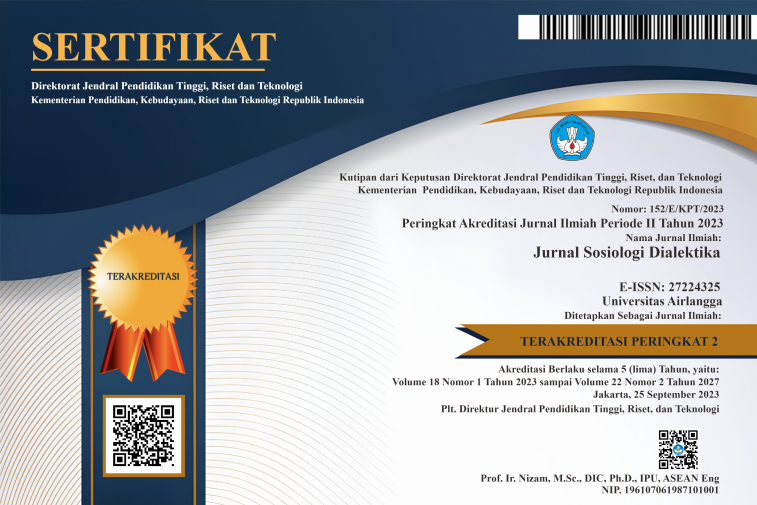Consumption practices of thrifting: Cultural materialism analysis of consumer perspectives
Downloads
In the global era, people are looking for alternatives in fashion through the thrifting trend. This research aims to analyze the consumption practices of thrifting in Surabaya from a consumer perspective through Marvin Harris’ Cultural Materialism approach based on economic infrastructure, social structure, and cultural superstructure. This research uses a quantitative approach with descriptive methods. The data collection technique was a questionnaire with 110 respondents in Surabaya, with ages between 15-40 years. Based on the frequency and preference of thrift shopping, thrift consumption is influenced by affordable prices, ease of access, and the role of digital technology. Economic infrastructure, including thrift stores to online platforms, makes it easy for consumers to obtain high quality stuff at low prices. Based on cultural values and meanings, thrifting is a symbol of sustainability, creativity, and identity expression. The shift in cultural superstructure reflects that second-hand clothing is accepted as a fashionable alternative that reflects social responsibility and uniqueness. Based on economic relations and local culture, thrifting is an activity that increases the potential of the informal economy by creating business opportunities and strengthening social networks. This research concludes that thrifting is not only an economic alternative but also part of a lifestyle that refers to the value of sustainability and has an impact on local culture.
Adji N & Claretta D (2022) The thrift shop phenomenon among teenagers: Da Watuna. Journal of Islamic Communication and Broadcasting 3 (1):36-44. https://doi.org/10.47467/dawatuna.v3i1.2201.
Akbar RJ & Prasetya MY (2023) Negara-negara yang industri tekstilnya hancur dirgerogoti perdagangan pakaian bekas impor. Viva, 21 March 2023. [Accessed 1 January 2025]. https://www.viva.co.id/bisnis/1585693-negara-negara-yang-industri-tekstinya-hancur-digerogoti-perdagangan-pakaian-bekas-impor.
Alfidyah NHI (2023) Budaya thrift dalam meningkatkan kelas sosial mahasiswa Fakultas Ilmu Sosial dan Ilmu Politik UIN Sunan Ampel Surabaya: Tinjauan Teori Hegemoni Antonio Gramsci. Undergraduate thesis, UIN Sunan Ampel, Surabaya.
Aravindh R & Thirupathi S (2019) Data analysis in social sciences: comparison between quantitative and qualitative research. International Journal of Management Research and Social Science 6 (1). https://doi.org/10.30726/ijmrss/v6.i1.2019.61002.
Arimbi DA, Wulan N, & Colombijn F (2020) Environmentalism and consumerism: The contradiction of globalization in the consumption behavior of the urban middle class in Surabaya, Indonesia. In: Kerr T, Ndimande B, Putten JV, Johnson-Mardones DF, Arimbi D, Amalia Y (ed). Urban Studies: Border and Mobility. Proceedings of the 4th International Conference on Urban Studies (ICUS 2017), December 8-9, 2017, Universitas Airlangga, Surabaya, Indonesia. 223-228. https://doi.org/10.1201/9780429507410-34.
Aryaputra R (2023) The thrifting phenomenon as an alternative solution related to reducing the environmental impact of fast fashion. Formosa Journal of Multidisciplinary Research 2 (8):1511-1526. https://doi.org/10.55927/fjmr.v2i8.5696.
Bardhi F & Arnould E (2005) Thrifty shopping: Combining utilitarian savings benefits and hedonic treat benefits. Journal of Consumer Behaviour 4 (4):223-233. https://doi.org/10.1002/cb.12.
Baur N (2019) Linearity vs. circularity? On some common misconceptions on the differences in the research process in qualitative and quantitative research. Frontiers in Education 4. https://doi.org/10.3389/feduc.2019.00053.
Beniulis S (2023) Thrift stores as environmental solutions: motivators of shoppers and donors. Studijos- Verslas - Visuomenė Dabartis Ir Ateities Įžvalgos 1 (VIII):36-44. https://doi.org/10.52320/svv.v1iviii.283.
Faerber A & Podkalicka A (2020) Austerity television: Narratives of survival, saving and living well. A thematic introduction. Culture Unbound Journal of Current Cultural Research 11 (3-4):421-442. https://doi.org/10.3384/cu.2000.1525.19v11a23.
Faerrosa L (2023) Study of consumer preferences to support the marketing strategy of the thrift clothing business. Sultanist Journal of Management and Finance 11 (2):141-148. https://doi.org/10.37403/sultanist.v11i2.510.
Halicki D, Zaborek P, & Meylan G (2024) Sustainable Fashion Choices: Exploring European Consumer Motivations behind Second-Hand Clothing Purchases. Administrative Sciences 14 (8):174. https://doi.org/10.3390/admsci14080174.
Harris M (2001) Cultural Materialism: The Struggle for a Science of Culture. Maryland: Rowman Altamira.
Harris M (1979) Cultural Materialism: The Struggle for a Science of Culture. New York: Random House.
Holmes H (2018) Dismantling the contemporary second-hand: survival in everyday life. The Sociological Review 67 (1):126-142. https://doi.org/10.1177/0038026118797837.
Hulme A (2019) The hedonic pleasure of frugality: convenience store shopping in hard times. Journal of Consumer Culture 19 (4):551-566. https://doi.org/10.1177/1469540519872068.
James S, Brown RB, Goodsell TL, Stovall J, & Flaherty J (2010) Adapting to hard times: Family participation patterns in local thrift economies. Family Relations 59 (4):383-395. https://doi.org/10.1111/j.1741-3729.2010.00610.x.
Kerlinger FN (1973) Founding of Behavior Research, Holt. New York: Rinchart and Winston Inc.
Kusindiyantri NT, Utari P, & Sudarmo S (2023) Digital communication’s role in shaping Indonesian thrift culture: A literature review. ICOHETECH 131-139. https://doi.org/10.47701/icohetech.v4i1.3382.
Lapolla K & Kim J (2015) Fashion design students as “thrift mavens”: An interpretive approach to how fashion design students can influence thrift shopping. In: International Textile and Apparel Association Annual Conference Proceedings 72 (1). Iowa State University Digital Press. https://doi.org/10.31274/itaa_proceedings-180814-112.
Larsen F (2023) Selling second-hand: Work practices in American thrift stores. Journal of Business Anthropology 12 (1). https://doi.org/10.22439/jba.v12i1.6914.
Lestari F & Asmarani R (2021) Thrifting culture during the COVID-19 pandemic and its impact on the environment. In: E3S Web of Conferences 317: 01006. EDP Sciences. https://doi.org/10.1051/e3sconf/202131701006.
McDonald T & Dan L (2020) “Pulling the fleece”: the hard work of online second-hand goods in Chinese factories. Journal of Consumer Culture 22 (2):398-416. https://doi.org/10.1177/1469540520955206.
Miller D (1987) Material Culture and Mass Consumption. Oxford: Basil Blackwell.
Morley D & Robins K (1995) Spaces of Identity: Global Media, Electronic Landscapes and Cultural Boundaries. London: Routledge.
Neuman WL & Kreuger L (2003) Social research methods: Qualitative and quantitative approaches. Boston: Allyn and Bacon.
Niu F (2023) The phenomenon of online thrift stores as a business opportunity for youngentrepreneurs in Manado City: A multicultural perspective. Kawanua International Journal of Multicultural Studies 4 (2):118-130. https://doi.org/10.30984/kijms.v4i2.687.
Novianti D (2021) Faktor-faktor yang mempengaruhi konsumen dalam pengambilan keputusan jual beli emas di Pasar Sentral Rappang (Analisis etika bisnis Islam). Thesis, IAIN Parepare, Parepare.
Putra M (2024) Customer interest in live streaming e-commerce for second-hand fashion repurchase systematic literature review. ILKOMNIKA 6 (1):102-116. https://doi.org/10.28926/ilkomnika.v6i1.610.
Rahmawati A, Febriyanti S, & Tutiasri R (2022) Thrifty shopping and fashion consumption among young urban Indonesians. JOMEC Journal 17: 119-135. https://doi.org/10.18573/jomec.224.
Singgih DS, Suyanto B, & Ariadi S (2022) Higher education capitalism in Indonesia as a social problem: A case study in the digital age. Jurnal Sosiologi Dialektika 17 (1):13-24. https://doi.org/10.20473jsd.v17i1.2022.13-24.
Siradjudin MA, Arief M, & Ekoputro W (2023) Fenomena Thrift Shopping Fashion Pada Pemuda Kec. Mulyorejo Surabaya. In: Prosiding Seminar Nasional Mahasiswa Komunikasi (Semakom) 1 (2): 673-678. https://conference.untag-sby.ac.id/index.php/semakom/article/view/2682.
Sugiyono PD (2018) Quantitative, Qualitative, and R&D Research Methods. Bandung: ALFABETA.
Syafa’ati SN & Khusyairi JA (2024) Thrift fashion trends as a new culture of consumerism. Airlangga Development Journal 8 (2):134-145.
Syaraahiyya A & Rusadi EY (2023) Fenomena thrift shopping di kalangan masyarakat akibat perubahan gaya hidup hidup modern (Studi globalisasi di wilayah Jawa Timur). Jurnal Dinamika Administrasi Bisnis 5 (1):2087-2093.
Venn S, Burningham K, Christie I, & Jackson T (2015) Consumption addicts or sustainable consumers: considering the grocery shopping practices of those transitioning to retirement. Aging and Society 37 (1):14-38. https://doi.org/10.1017/s0144686x15000975.
Zahro Y (2023) Meaning of thrifting in the #tukarbaju campaign in the zero waste Indonesia community. Lontar Journal of Communication Science 11 (1). https://doi.org/10.30656/lontar.v11i1.5626.

This work is licensed under a Creative Commons Attribution-NonCommercial-ShareAlike 4.0 International License.
1. Copyright of this journal is possession of Editorial Board and Journal Manager, by the knowledge of author, whilst the moral right of the publication belongs to the author.
2. Legal formal aspect of journal publication accessibility refers to Creative Commons Attribution-NonCommercial-ShareAlike (CC BY-NC-SA), implies that publication can be used for non-commercial purposes in its original form (cannot be modified).
3. Every publications (printed/electronic) are open access for educational purposes, research, and library. Other that the aims mentioned above, editorial board is not responsible for copyright violation.















